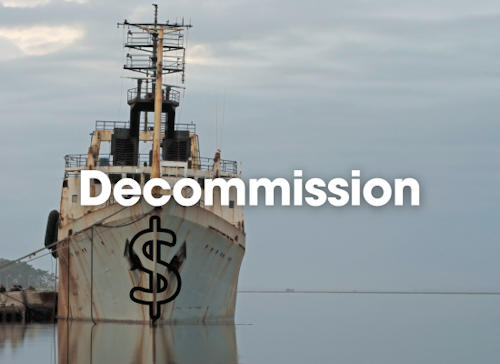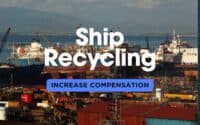The Financial Impact of Ship Decommissioning: Planning Ahead

Decommissioning a ship involves several layers of costs—some obvious and some that might not spring to mind immediately. Here’s an overview of what you can expect:
* Please send feedback/suggestions to editor @ shipuniverse.com
Direct Costs
- Removal and Disposal of Hazardous Materials
- Before a ship can be dismantled, any hazardous materials, such as asbestos, lead-based paints, and oils, must be safely removed and disposed of. This process is not only labor-intensive but also requires specialized handling to meet environmental safety standards. For instance, the cost of asbestos removal alone can range from $5,000 to $30,000 depending on the extent of asbestos present and the size of the ship.
- Costs Associated with Dismantling and Recycling the Ship’s Structure
- The physical dismantling of a ship can be a mammoth task. The cost here depends largely on the size and type of the ship. For a large cargo ship, dismantling can run anywhere from $1 million to $4 million. The good news? Some of the materials, particularly steel, can be sold for scrap, which can help offset some of these costs.
Indirect Costs
- Legal and Administrative Expenses
- Navigating the regulatory waters of ship decommissioning involves various legal and administrative costs. These might include fees for obtaining necessary permits, legal costs for ensuring compliance with international maritime laws, and administrative fees. Collectively, these could add up to about 5-10% of the total decommissioning budget.
- Environmental Cleanup and Monitoring Costs
- If your ship has been docked or operational in environmentally sensitive areas, you might face additional costs for environmental cleanup. This could involve soil and water testing and remediation if pollutants have been detected. For example, environmental cleanup operations can easily exceed $100,000, depending on the pollution level and local environmental regulations.
Hidden Costs
- Potential Penalties for Non-Compliance with Environmental Regulations
- This is a big one. Failing to comply with environmental regulations can lead to hefty fines. For instance, penalties for violating the U.S. Clean Water Act can reach up to $50,000 per day of violation. It’s crucial to factor in the potential financial impact of any non-compliance.
- Reputation Risks and Their Financial Implications
- The way a ship is decommissioned can significantly impact a company’s reputation. Poor practices can lead to negative media coverage, which can deter potential business and affect profitability. While hard to quantify, the cost of lost business can be far greater than the cost of proper decommissioning.
Revenue Streams from Decommissioning
While decommissioning a ship involves significant costs, it also presents several opportunities to recoup investments and even turn a profit. Understanding where these opportunities lie is crucial for maximizing returns.
Sale of Recyclable Materials
- Types of Materials That Can Be Sold
- Ships are treasure troves of recyclable materials. Steel is the most abundant material in most ships and can often cover a substantial portion of decommissioning costs when sold as scrap. Other valuable metals like copper, found in electrical systems, and aluminum, used in superstructures, can also fetch good prices. Depending on the ship’s size and material composition, you might recover materials worth anywhere from $500,000 to over $1 million.
- Market Factors Affecting Prices of Recycled Materials
- The revenue from selling scrap materials can fluctuate based on global commodity prices, which are influenced by factors like international demand, supply chain issues, and geopolitical events. Keeping an eye on these trends can help you choose the best time to sell the materials, maximizing your returns.
Resale of Functional Components
- Opportunities for Selling Engines, Navigation Equipment, and Other Valuable Parts
- Many components of a ship, if they’re still in good working condition, can be resold. Engines, especially those well-maintained, can be a significant revenue source. Navigation systems, radar equipment, and even generators hold substantial resale value. For instance, a medium-sized marine diesel engine can be sold for anywhere from $20,000 to $100,000.
- Best Practices for Assessing and Marketing These Components
- Proper assessment is key to maximizing resale value. Have experts inspect the components to ensure they are in good condition and appraise their value. Marketing these items effectively also matters—utilizing online marketplaces, industry contacts, and auctions can help you reach the right buyers who value and are willing to pay a premium for quality marine equipment.
Potential for Reclaiming Real Estate
- Financial Benefits of Repurposing the Land or Berth Formerly Occupied by the Decommissioned Ship
- Once a ship is decommissioned, the space it occupied, whether at a dockyard or a berth, can be repurposed for other uses. This reclaimed real estate can be used for expanding current operations, leasing to other maritime businesses, or developing commercial properties, providing a steady income stream. For example, converting an old berth into a container storage area could yield thousands of dollars per month in leasing revenue.
Strategic Planning for Cost-Effective Decommissioning
Strategic planning is essential when decommissioning a ship. By carefully considering timing, selecting the right partners, and leveraging technology, you can significantly reduce costs and boost potential revenues.
Timing Considerations
- How the Timing of Decommissioning Can Impact Costs and Revenues
- The timing of decommissioning a ship can greatly influence both the costs incurred and the revenues gained from the process. For instance, decommissioning during a downturn in steel prices might result in lower returns from the sale of scrap metal. Conversely, timing your decommissioning when the market for steel and other recyclable materials is booming can substantially increase your revenue.
- The Importance of Monitoring Market Conditions for Scrap and Reusable Materials
- Keep a close eye on market trends for scrap materials and reusable components. The prices for metals like steel, copper, and aluminum can fluctuate widely based on global demand and supply scenarios. By staying informed and choosing to decommission during favorable market conditions, you can maximize the financial returns from selling these materials.
Choosing the Right Partners and Vendors
- Criteria for Selecting Dismantling Yards and Recycling Facilities
- Not all dismantling yards and recycling facilities are created equal. When selecting a partner, consider their reputation, environmental compliance record, and the efficiency of their operations. The facility should adhere to the Basel Convention regulations to avoid legal repercussions and potential fines. Also, assess their capability to handle the specific types of materials and components your ship contains.
- Ensuring Compliance with International Standards and Laws
- Compliance with international standards and laws is non-negotiable. Work with partners who are well-versed in the legal aspects of ship decommissioning and can ensure that all activities are carried out in accordance with international guidelines. This helps avoid costly legal battles and fines, which can arise from non-compliance with environmental or shipping regulations.
Notable Case Studies
Exploring successful ship decommissioning projects provides valuable lessons and insights that can guide future endeavors. Here are two notable examples:
1. The Decommissioning of the USS Ranger (CV-61)
Project Overview: The USS Ranger, a former U.S. Navy aircraft carrier, was decommissioned and sold for scrap in 2014. The dismantling took place in Brownsville, Texas, by International Shipbreaking Limited, a company known for its environmentally responsible practices.
Lessons Learned:
- Environmental Compliance: The project adhered strictly to environmental regulations, showcasing the importance of environmental stewardship in ship decommissioning. The company implemented measures to prevent pollution and safely dispose of hazardous materials.
- Community Engagement: The project maintained transparent communication with the local community and regulatory bodies, highlighting the value of community involvement in large-scale decommissioning projects.
2. Decommissioning of the North Sea Producer
Project Overview: The North Sea Producer, a floating production storage and offloading (FPSO) vessel, was decommissioned in 2016. The decommissioning was carried out in Teesside, UK, and involved extensive planning to handle the complex nature of FPSO units.
Lessons Learned:
- Advanced Planning: The success of the project was largely due to meticulous planning that addressed the specific challenges posed by FPSO units, such as dealing with residual hydrocarbons and large amounts of oily water.
- Innovative Solutions: The project utilized cutting-edge technology for cleaning and dismantling, which not only expedited the process but also ensured that it met all safety and environmental standards.
Future Trends in Ship Decommissioning
The ship decommissioning industry is poised to evolve significantly in the coming years, driven by regulatory changes and technological advancements. Here’s what to expect:
Emerging Regulations and Their Potential Financial Impact
- Increased Stringency in Environmental Regulations: As global attention on environmental impact intensifies, regulations governing ship decommissioning are expected to become stricter. This will likely increase the compliance costs but can also open opportunities for companies specializing in environmentally friendly decommissioning services.
- Implementation of the Hong Kong International Convention: Although not yet in force, this convention will set international standards for the safe and environmentally sound recycling of ships. Its adoption will have significant financial implications, requiring ship owners to invest in compliant decommissioning practices.
Innovations in Recycling Technology and Their Implications for the Decommissioning Market
- Enhanced Material Recovery: Technological advancements are expected to improve the efficiency of material recovery during decommissioning, reducing waste and increasing the value derived from scrap materials.
- Automation and Robotics: The use of robotics in the dismantling process will continue to grow, potentially reducing labor costs and improving safety and efficiency. This can make decommissioning more cost-effective and less time-consuming.

Do you have a Maritime Product or Service that may be of interest to Shipowners? Tell us about it here!
Do you have feedback or insights? Please reach out to editor @ shipuniverse.com


